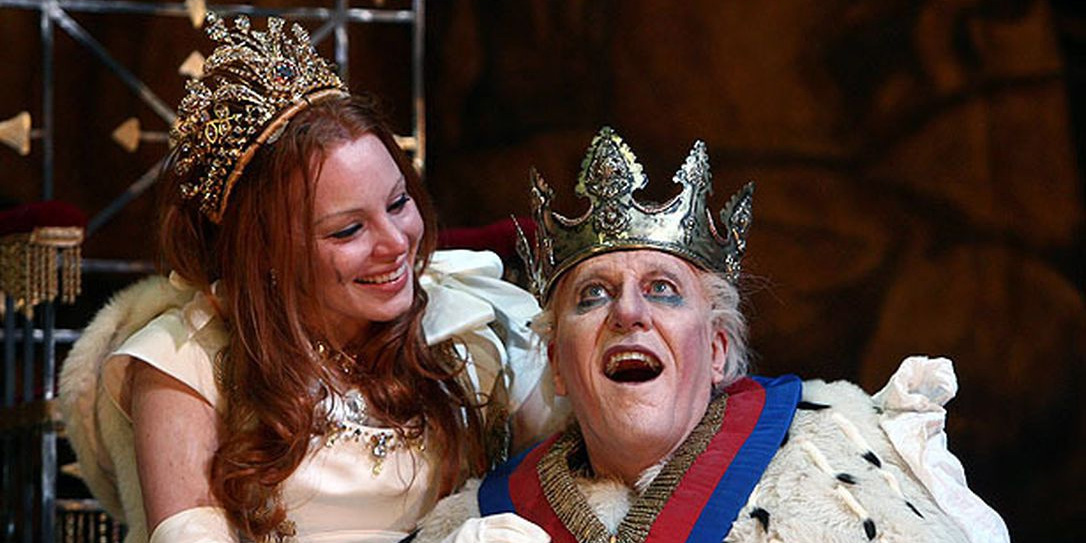“Nothing’s abnormal when abnormal has become the new normal,” declares Geoffrey Rush, a short distance into his astonishing performance as the dying monarch in “Exit the King.” It’s that state of pervasive uncertainty, in a world thrown into chaos as an empire crumbles, that rescues Eugene Ionesco’s 1962 absurdist tragedy from the dusty vaults and infuses it with unexpected currency. But the play’s relevance is secondary to the virtuoso work of its lead actor, who unleashes a dazzling arsenal of mime, clowning and physical techniques to swerve in an instant between comedy and pathos, keeping the audience riveted to him through every hairpin turn.
Rush and director Neil Armfield, who collaborated on the irreverent adaptation of one of Ionesco’s more linear texts, first staged the play in Australia in 2007, building the production around the actor’s specific skill set. Since then, much has changed to render the work more trenchant, notably the exit of an out-of-touch administration, heedless to the wreckage being left in its wake.
While it’s set in an abstract time and place, only someone sleeping through the production would miss the connections. King Berenger is a warmongering, autocratic ruler surrounded by loyalists on one side and self-serving antagonists on the other. His palace is cracked, his kingdom disintegrating, his governmental experts perished, his populace enfeebled and his washing machine pawned to bail out the treasury. Even nature, the planets and time have turned against him. “The frolics are over,” hisses Queen Marguerite (Susan Sarandon), his embittered first wife.
The play has a built-in spoiler right at the start. “You are going to die in an hour and a half,” Marguerite informs her husband. “You are going to die at the end of the play.” That occurs by agonizing degrees as Rush’s petulant, pajama-clad 400-year-old king works through denial, anger, bargaining, accelerated deterioration and reluctant acceptance in an agitated state of Beckettian suspension. Even as he refuses to let go, railing at the loss of his powers, Berenger frets over his legacy, oblivious to the fact that he has driven his empire into the ground.
But it’s the production’s humanism, more than its political parallels, that keeps it compelling. This is above all an existential examination of death, of the terrifying contemplation of the void beyond and the helplessness that comes with sudden loss of physical strength and mental faculties. In his Broadway debut, Rush’s supreme achievement is that he forces us to empathize with such a buffoonish, despotic gargoyle.
Despite the antic tone of much of the performance — full of tumbles and pratfalls, nifty scepter tricks and even a Buster Keaton-esque marching-band dance — there’s an emotional undertow at play, and not just when Rush stops cavorting.
In one especially penetrating passage, he steps off the stage to wander the aisles, his face ashen as he calls to the dead for guidance. In another scene, Berenger’s Marie Antoinette-like condescension is underscored by the desperation of someone clinging enviously to life as he romanticizes the pain, boredom and drudgery of Juliette (Andrea Martin), cleaning woman and registered nurse to Their Majesties.
Considering how aggressively much of the production is pitched toward outlandish comedy, its sorrow creeps up on you as stealthily as the ambient soundscape by Russell Goldsmith and composer John Rodgers.
Not everyone rises to Rush’s level, but Martin’s gift for physical comedy has rarely been better utilized than in her cartoonish characterization. As the purse-lipped court doctor, William Sadler deftly exploits an unpitying vein in the playwright’s humor, while Brian Hutchison clanks around amusingly as an armor-clad guard, bellowing royal decrees. The monologue in which he reveals his soft spot for the king via an unlikely catalog of the monarch’s achievements — everything from splitting the atom to penning the collected works of Shakespeare to inventing the search engine — is strangely touching. “He cut off a few heads. It’s true,” concedes the guard. “It was for national security.”
Berenger’s queens are more uneven. If Lauren Ambrose doesn’t quite have the technique to match Rush’s quicksilver shifts, she’s nonetheless radiant as the adoring second wife who tries to cushion his pain with love. She hurls herself bravely into the spirit of a production that plays everything large, climbing to melodramatic heights without fear of seeming foolish.
With her Marge Simpson hair-tower caged in bling, Sarandon is an arresting ice queen, her back arched and legs akimbo as she looks on coldly, clenching and unclenching her gloved fingers. There are sharp moments in Sarandon’s venomous comments, but authority is lacking. Absent from Broadway since 1972, she maintains her naturalistic screen style in a role that calls for something bolder.
But in the unsettling final scene, in which the rest of the court has literally vaporized, leaving Marguerite alone to coax the now blind and deaf Berenger toward his demise, Sarandon mesmerizes, addressing him like a nurturing mother to a confused child. The scene is made more beautiful still by the final descent into sepulchral gloom of Damien Cooper’s lighting and the lowering of the faded royal curtains and exotic backcloths that drape Dale Ferguson’s effective circus-style set.
From the pompously heralded comic entrances, as Their Majesties stride on with Juliet scurrying behind to manage their unwieldy cloaks (also Ferguson’s nifty handiwork), Armfield establishes the playful tone of a burlesque. But the adapters extract something poignant and troubling from their portrait of a vain, vindictive king who, almost to the end, would sacrifice anyone from the court to prolong his own life. As Berenger’s body systematically shuts down, his last gasp leaves us all staring into the abyss.
